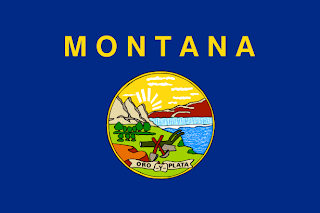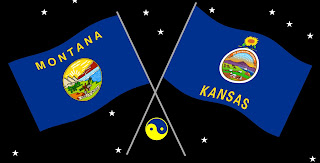Flag of Montana
 Did'ja
Did'ja ever notice some of the state flags look familiar? I did, but I didn't stop there. I went the distance and paired each state with a so called sibling look a like. And for the record, Montana's look a like twin is Kansas.
Both banners are locked and loaded by fields of blue with
yeller' letters. On top of that both have
matchin' seals of a similar nature. Since they both show us an
idyllic scene down by the river. But they differ like potential and kinetic energy. Or rather like dawn and dusk. Ya see, the flag of Kansas is the busiest of busy flags. It has the most people, animals and activity. How many persons can you count? How many animals are there?
Flag of Kansas

No other flag in the union comes close to Kansas. There are at least five people on the flag, and more than 13 animals. On the other hand, Montana is the essence of quiet tranquility. No people, no critters - only the eye of the observer. The hustle and bustle of Kansas reflects the morning rush hour, while empty calm of Montana is like dusk when everyone has gone home ands'
settlin' in for supper.
Furthermore the position of the sun in transition over the hills on each flag is in the proper place that map makers consider east and west. You can orient a map any which way, but in the USA we usually mark the forward/up position as north, the right hand side as east, the left hand side as west. Likewise the sun on Kansas is in a would be eastern-right side, while the sun of Montana is on the would be west-left side.
Close up of Montana Flag
Kansas is snuggled in the heartland of America in between the West and East. Although Kansas gets first dibs as being the heartland of America, in a way Montana is the heartland of the continent. When you look at a map of the USA, Kansas snuggled in the middle, likewise when you look at a map of North America, Montana is a would be monkey in the middle.
A key historical alignment of matching caliber is that both Montana and Kansas took a bullet for America, or rather both states were pierced in the heart by an arrow of historic proportions. The events of
Bleeding Kansas are considered the opening
pre-game season of the US Civil War. The War officially started on April 12, 1861 but little bits of terror were breaking loose all over from
Harper's Ferry, Virginia to
Lawrence, Kansas.
Close up of Kansas Flag

The matching event for Montana to Kansas is related to the closing phase of the Native American Indian Wars. The key note sung by General Custer. Officially the War on Native Americans ended in 1890 at Wounded Knee, South Dakota. But the sharpest footnote of the violent struggle between Natives and Newcomers transcends time at Little Bighorn, Montana
But before the outbreak of succession of the Southern Slave Holding States, the debate between ending slavery and letting it expand in the new states reached a
raucous roar in Kansas. The congressmen of America passed the buck to the settlers of Kansas. Subsequently pro-slavery and abolitionist groups raced to Kansas in order to make it in their own image. In the ensuing chaos, the rash of violence and the political bloodshed became known as Bleeding Kansas.
Sisters of the Prairie - Kansas and Montana

Less than a generation later, another golden bullet was shot into the heart of America, with the tragic story of
Custer's Last Stand. General Custer was a dashing, brash, and high held hero of the US Civil War for the Union Side. However his intuitive one man
rambo style tactics resulted in his death and the death of the men under his command. The painful fact was that it happened on the eve of America's 100
th birthday - late June 1876. The US was steadily recovering from the madness and scars of civil war, and feelings of higher hopes were in the air. But news of this lopsided battle put slight damper on America's Centennial.
Custer's Last Stand and
Bleeding Kansas are two Aces of American History. They are tragic yet hopeful echos of our past. The Native American and Confederate are united in a similar destiny but under different stars. Both groups saw their ancient way of life come to an end under violent restriction from the US Government. No longer would the nation tolerate the right to own a man or the right to roam freely across the plains. Even today a lingering pain remains on all sides.
Likewise General Custer lost some luster as a hero of the American West. As America grew into maturity she reevaluated the status of Native Americas. The limelight of history shifted in remembrance and favor for the Native American. The fall of Custer and his men challenge us to remember our past. General Custer risked his life for the Union and in
a serendipitous line gave up his life, so we wound not forget the Native American.
Forlorn are America's ancient ways of life, but perhaps America is ready for a new kind of limelight that sparkles on all sides, where an unlimited range of colours shine upon the past. Where all men and women can be seen as heroes rather than
villans?














